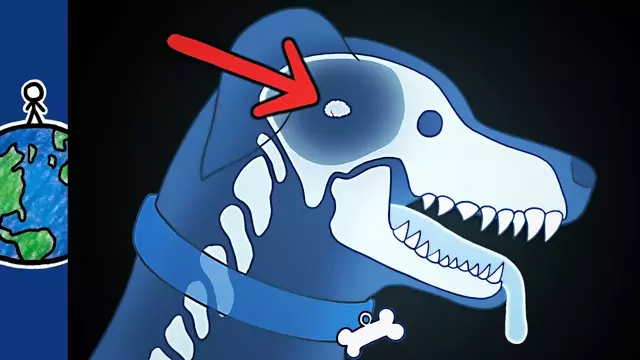2017-12-06
[public] 950K views, 23.3K likes, dislikes audio only
When we domesticate an animal species, their brains shrink and they freak out less.
LEARN MORE
**************
To learn more about this topic, start your googling with these keywords:
- Domesticated animal: a species of animal bred by humans over generations to become nonreactive and gain characteristics suitable for life as a farm animal or pet
- Tame animal: an individual animal raised in a way that it has become less dangerous and frightened of people
- Feral animal: an animal that escapes from captivity or domestication (& regains some similar & some different characteristics compared to its pre-domesticated state)
- "Fight or flight": an instinctive physiological response to a threatening situation that readies a creature to either to resist forcibly or escape
- Limbic system: the brain’s “panic button” - a system of nerves and networks near the bottom of the cortex that controls basic emotions (e.g. fear, pleasure, anger) and drives (e.g. hunger, sex, dominance)
- Telencephalon: the most developed and anterior part of the forebrain, consisting chiefly of the cerebral hemispheres, and the brain region that shrinks most in domesticated animals
- Domestication: a sustained multigenerational, mutualistic relationship in which one species (e.g. humans) assumes a significant degree of influence over the reproduction and care of another species (e.g. cows) in order to secure a more predictable supply of a resource of interest (e.g. milk/meat/traction), and through which the domesticated organisms gain advantage over individuals that remain outside this relationship (e.g. aurochs, which went extinct), thereby benefitting and often increasing the fitness of both species involved
If you liked this week’s video, you might also like:
Brain Scoop video on brain size and intelligence: https://www.youtube.com/watch?v=hJW8jIDfP9E
Russian Fox Domestication Experiment: https://goo.gl/5nWnXz
What happens to domesticated animals & their brains when they escape back to the wild?: http://www.nature.com/news/when-chickens-go-wild-1.19195#/free%5C
CREDITS
*********
Script Writer: Alex Reich
Script Editor: Emily Elert
Video Illustrator: Keenan Parry & Ever Salazar
Video Director: Emily Elert
Video Narrator: Emily Elert
With Contributions From: Henry Reich, Kate Yoshida, Ever Salazar, Peter Reich, David Goldenberg
Music by: Nathaniel Schroeder
MinuteEarth is produced by Neptune Studios LLC
SUPPORT MINUTEEARTH
**************************
If you like what we do, you can help us!:
- Become our patron: https://patreon.com/MinuteEarth
- Our merch: https://dftba.com/minuteearth
- Our book: https://minuteearth.com/books
- Share this video with your friends and family
- Leave us a comment (we read them!)
OUR LINKS
************
Youtube | https://youtube.com/MinuteEarth
TikTok | https://tiktok.com/@minuteearth
Twitter | https://twitter.com/MinuteEarth
Instagram | https://instagram.com/minute_earth
Facebook | https://facebook.com/Minuteearth
Website | https://minuteearth.com
Apple Podcasts| https://podcasts.apple.com/us/podcast/minuteearth/id649211176
REFERENCES
**************
Agnvall, B. et al. 2017. Is evolution of domestication driven by tameness? A selective review with focus on chickens. Applied Animal Behaviour Science. https://doi.org/10.1016/j.applanim.2017.09.006
Eberhard, W. G., & Wcislo, W. T. 2011. Grade changes in brain-body allometry: morphological and behavioural correlates of brain size in miniature spiders, insects and other invertebrates. Advances in Insect Physiology, 40, 155. http://www.stri.si.edu/sites/publications/PDFs/2011_Eberhard_Wcislo_AdvIns_Physiol.pdf
Kruska, D. C. 2005. On the evolutionary significance of encephalization in some eutherian mammals: effects of adaptive radiation, domestication, and feralization. Brain, behavior and evolution, 65(2), 73-108. https://goo.gl/J86NEd
Kruska, D. C. Personal Communication, Oct 2017.
Marchetti, M. P., & Nevitt, G. A. 2003. Effects of hatchery rearing on brain structures of rainbow trout, Oncorhynchus mykiss. Environmental biology of Fishes, 66(1), 9-14. https://goo.gl/GL6LWG
Marchetti, M. Personal Communication, Oct 2017.
Wright, D. Personal Communication, Oct 2017.
Zeder, M. A. 2012. Pathways to animal domestication. Biodiversity in agriculture: Domestication, evolution and sustainability, 227-259. https://goo.gl/2xWSB8
Zeder, M. A. 2015. Core questions in domestication research. Proceedings of the National Academy of Sciences, 112(11), 3191-3198. http://www.pnas.org/content/112/11/3191.full
Zeder, M. A. Personal Communication, Oct 2017.
/youtube/video/vWAA-SrrFUQ
/youtube/video/o6JVMmkBF-I
http://patreon.com/minuteearth
/youtube/channel/UCeiYXex_fwgYDonaTcSIk6w
https://www.patreon.com/minuteearth
/youtube/video/4DF94Wvtekk

